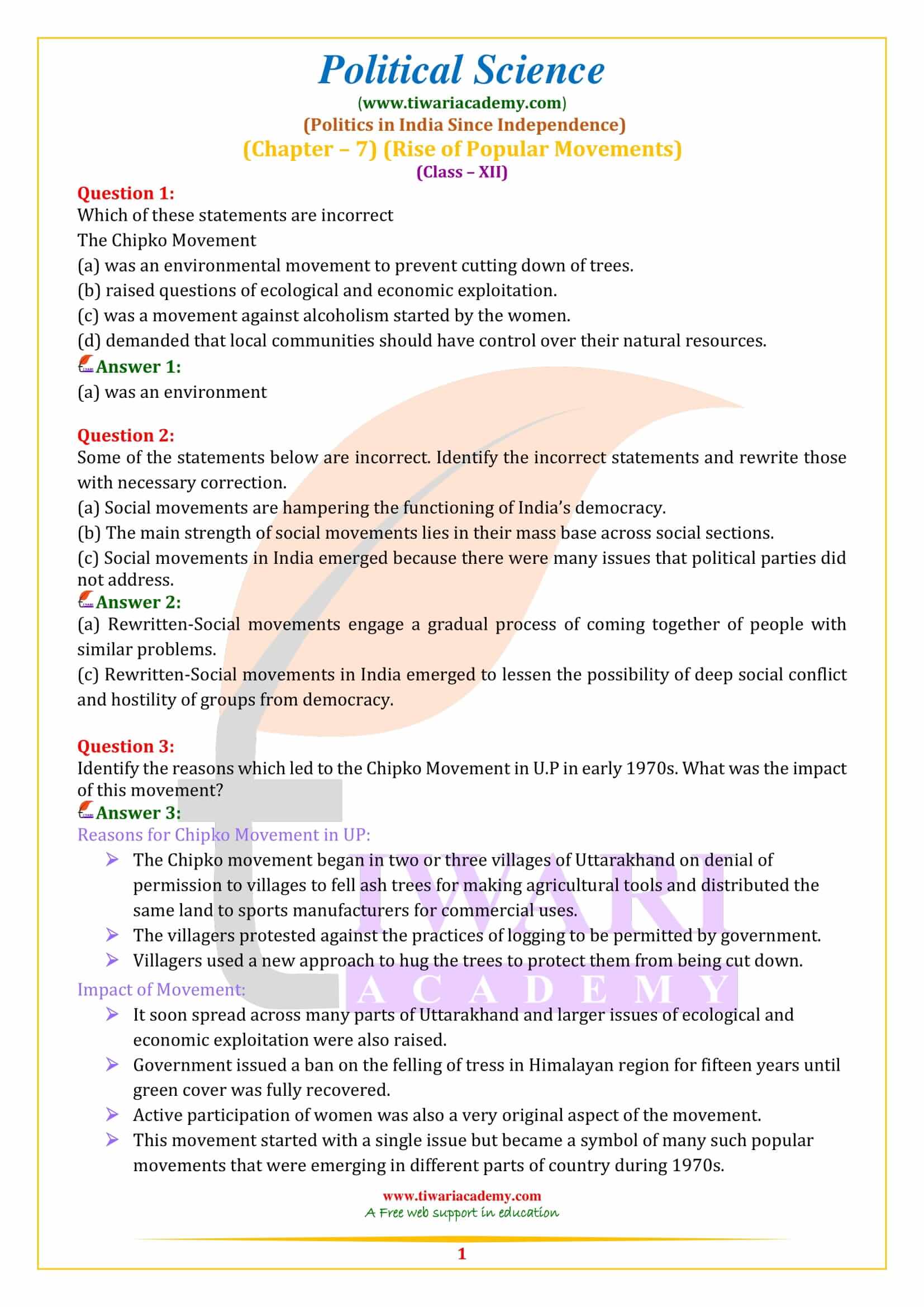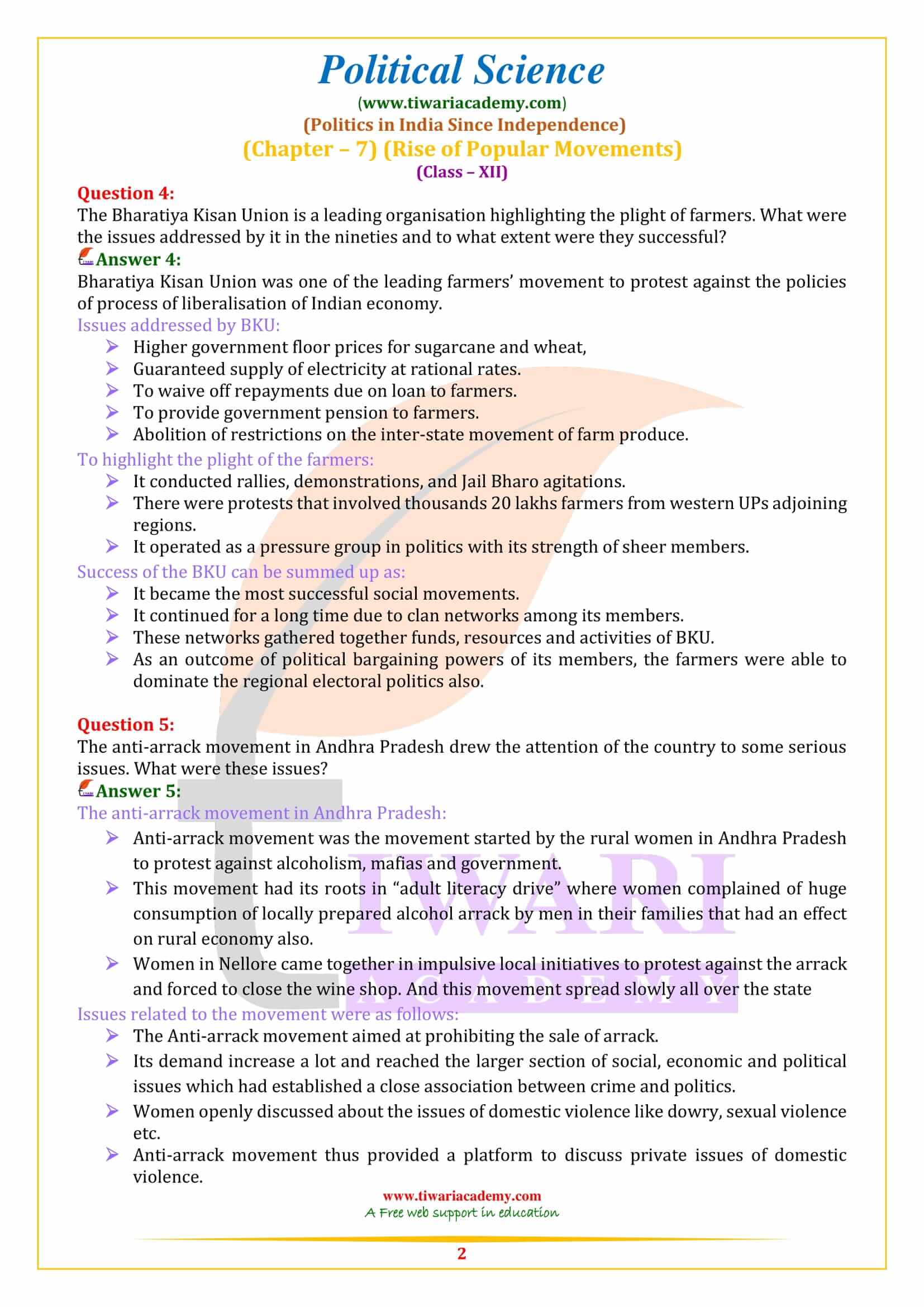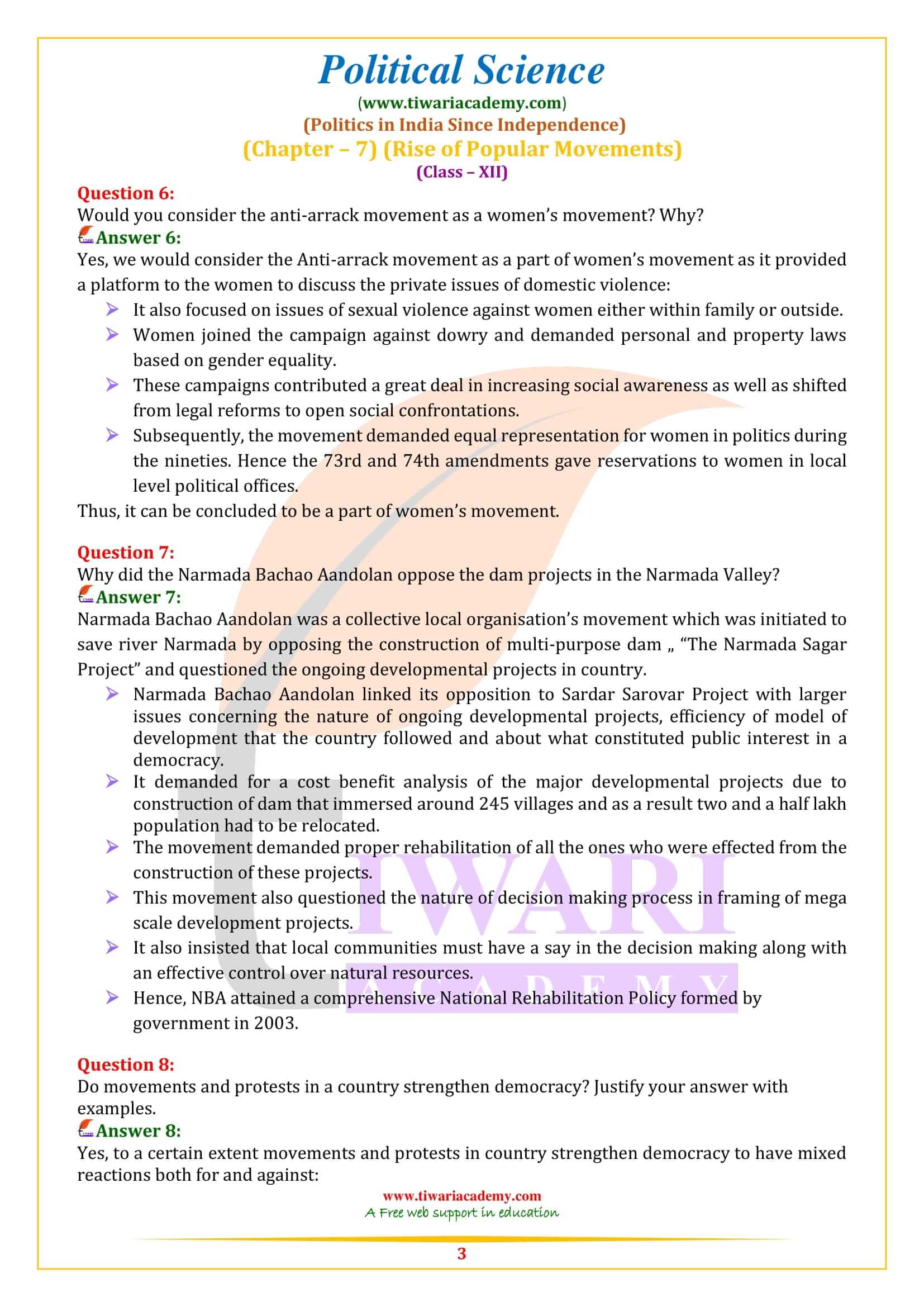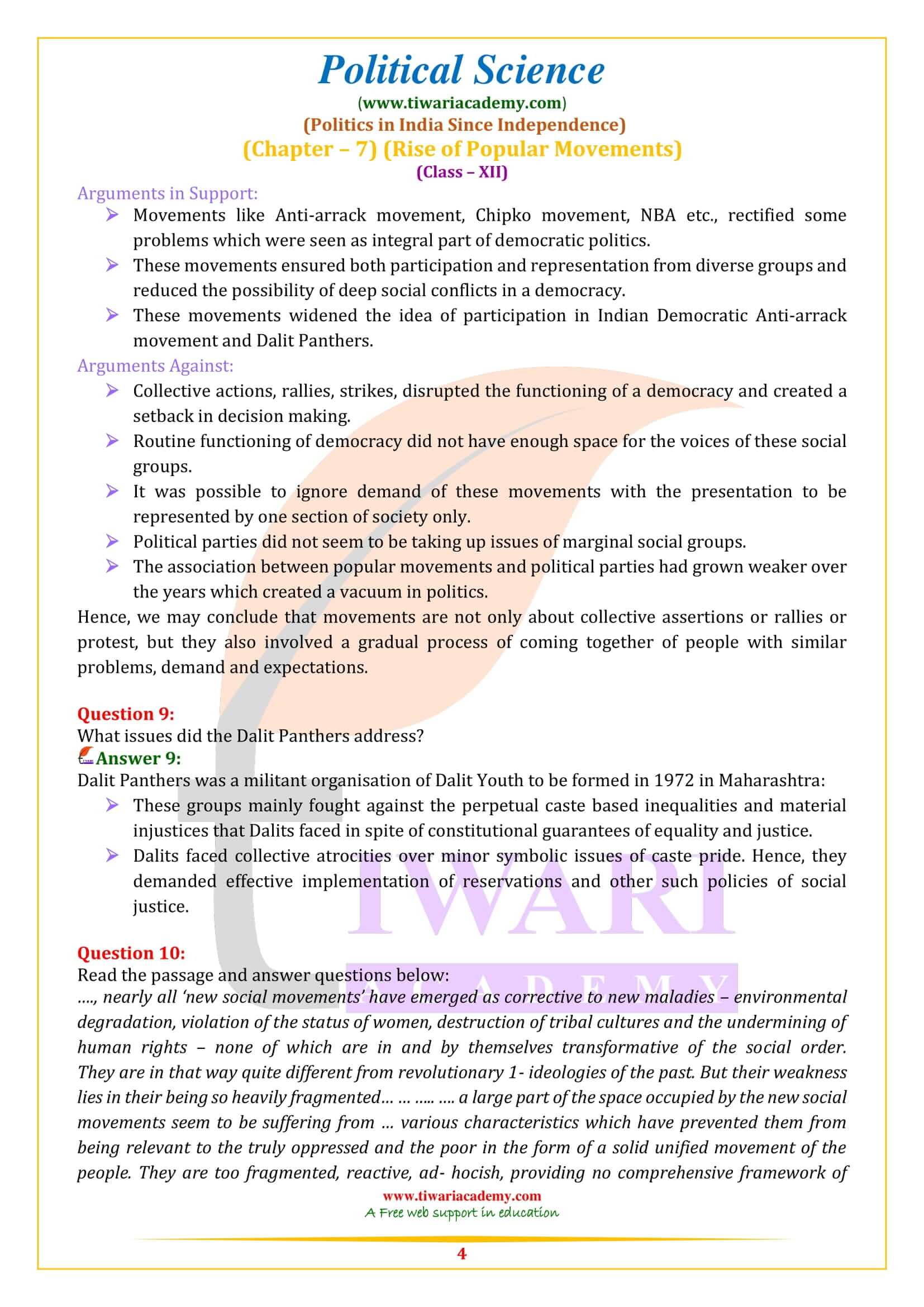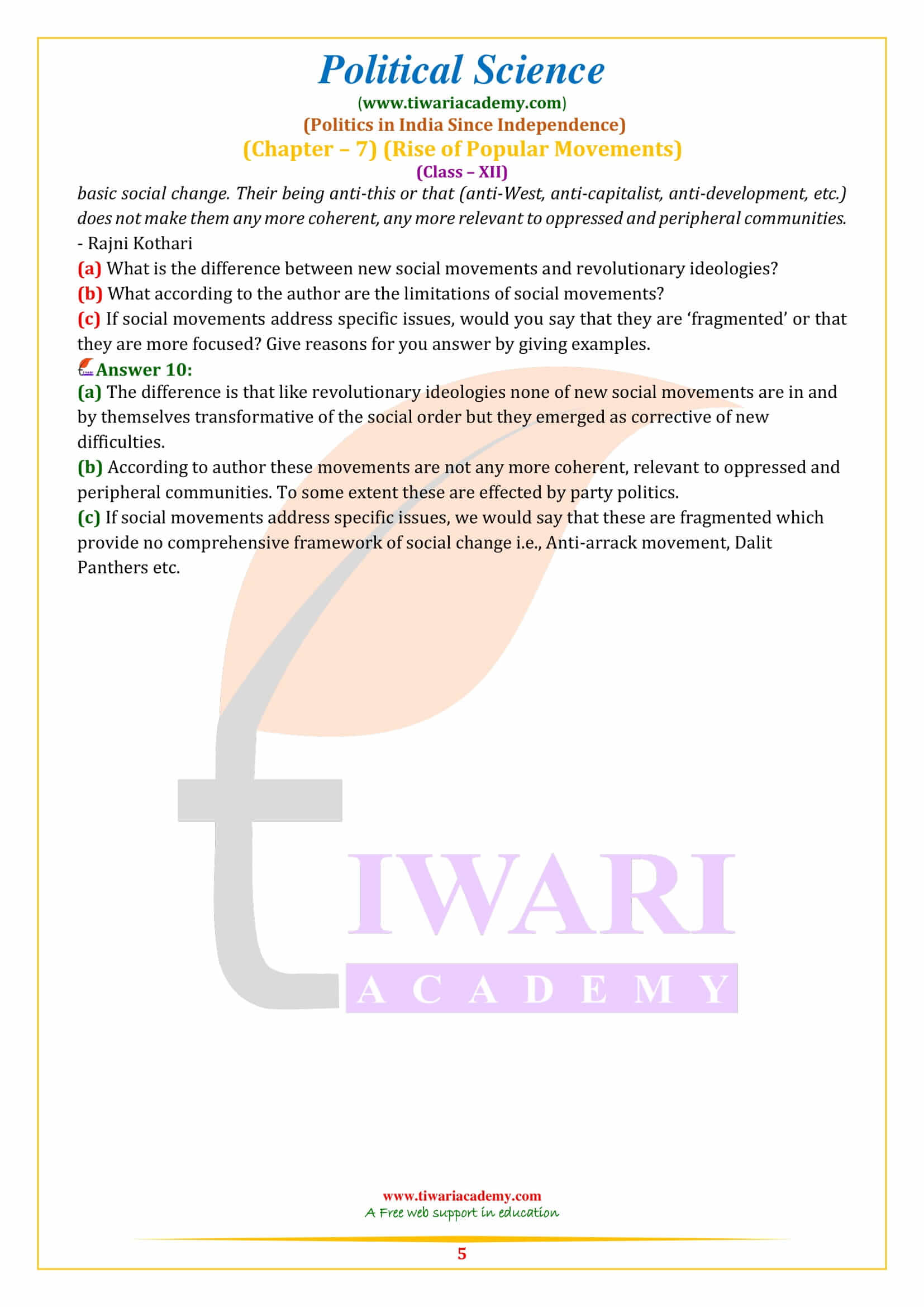NCERT Solutions for Class 12 Political Science Part 2 Chapter 7 Rise of Popular Movements in English and Hindi Medium for new session 2024-25. Solutions of Class 12 Political Science Part 2 Politics in India since Independence chapter 7 are easy to learn and understand format. The videos of Hindi medium solutions are also given to download.
NCERT Solutions for Class 12 Political Science Chapter 7
Class 12 Political Science Chapter 7 Rise of Popular Movements
Class 12 Political Science Chapter 7 MCQ
Which of these statement is correct about the Chipko Movement
Identify the reasons which led to the Chipko Movement in U.P in early 1970s. What was the impact of this movement?
Reasons for Chipko Movement in UP:
- The Chipko movement began in two or three villages of Uttarakhand on denial of permission to villages to fell ash trees for making agricultural tools and distributed the same land to sports manufacturers for commercial uses.
- The villagers protested against the practices of logging to be permitted by government.
- Villagers used a new approach to hug the trees to protect them from being cut down.
Impact of Movement:
- It soon spread across many parts of Uttarakhand and larger issues of ecological and economic exploitation were also raised.
- Government issued a ban on the felling of tress in Himalayan region for fifteen years until green cover was fully recovered.
- Active participation of women was also a very original aspect of the movement.
- This movement started with a single issue but became a symbol of many such popular movements that were emerging in different parts of country during 1970s.
The Bharatiya Kisan Union is a leading organisation highlighting the plight of farmers. What were the issues addressed by it in the nineties and to what extent were they successful?
Bharatiya Kisan Union was one of the leading farmers’ movement to protest against the policies of process of liberalisation of Indian economy.
Issues addressed by BKU:
- Higher government floor prices for sugarcane and wheat,
- Guaranteed supply of electricity at rational rates.
- To waive off repayments due on loan to farmers.
- To provide government pension to farmers.
- Abolition of restrictions on the inter-state movement of farm produce.
To highlight the plight of the farmers:
- It conducted rallies, demonstrations, and Jail Bharo agitations.
- There were protests that involved thousands 20 lakhs farmers from western UPs adjoining regions.
- It operated as a pressure group in politics with its strength of sheer members.
Success of the BKU can be summed up as:
- It became the most successful social movements.
- It continued for a long time due to clan networks among its members.
- These networks gathered together funds, resources and activities of BKU.
- As an outcome of political bargaining powers of its members, the farmers were able to dominate the regional electoral politics also.
The anti-arrack movement in Andhra Pradesh drew the attention of the country to some serious issues. What were these issues?
The anti-arrack movement in Andhra Pradesh:
- Anti-arrack movement was the movement started by the rural women in Andhra Pradesh to protest against alcoholism, mafias and government.
- This movement had its roots in “adult literacy drive” where women complained of huge consumption of locally prepared alcohol arrack by men in their families that had an effect on rural economy also.
- Women in Nellore came together in impulsive local initiatives to protest against the arrack and forced to close the wine shop. And this movement spread slowly all over the state
Issues related to the movement were as follows:
- The Anti-arrack movement aimed at prohibiting the sale of arrack.
- Its demand increase a lot and reached the larger section of social, economic and political issues which had established a close association between crime and politics.
- Women openly discussed about the issues of domestic violence like dowry, sexual violence etc.
- Anti-arrack movement thus provided a platform to discuss private issues of domestic violence.
Would you consider the anti-arrack movement as a women’s movement? Why?
Yes, we would consider the Anti-arrack movement as a part of women’s movement as it provided a platform to the women to discuss the private issues of domestic violence:
- It also focused on issues of sexual violence against women either within family or outside.
- Women joined the campaign against dowry and demanded personal and property laws based on gender equality.
- These campaigns contributed a great deal in increasing social awareness as well as shifted from legal reforms to open social confrontations.
- Subsequently, the movement demanded equal representation for women in politics during the nineties. Hence the 73rd and 74th amendments gave reservations to women in local level political offices.
Thus, it can be concluded to be a part of women’s movement.
Why did the Narmada Bachao Aandolan oppose the dam projects in the Narmada Valley?
Narmada Bachao Aandolan was a collective local organisation’s movement which was initiated to save river Narmada by opposing the construction of multi-purpose dam „ “The Narmada Sagar Project” and questioned the ongoing developmental projects in country.
- Narmada Bachao Aandolan linked its opposition to Sardar Sarovar Project with larger issues concerning the nature of ongoing developmental projects, efficiency of model of development that the country followed and about what constituted public interest in a democracy.
- It demanded for a cost benefit analysis of the major developmental projects due to construction of dam that immersed around 245 villages and as a result two and a half lakh population had to be relocated.
- The movement demanded proper rehabilitation of all the ones who were effected from the construction of these projects.
- This movement also questioned the nature of decision making process in framing of mega scale development projects.
- It also insisted that local communities must have a say in the decision making along with an effective control over natural resources.
- Hence, NBA attained a comprehensive National Rehabilitation Policy formed by government in 2003.
Do movements and protests in a country strengthen democracy? Justify your answer with examples.
Yes, to a certain extent movements and protests in country strengthen democracy to have mixed reactions both for and against:
Arguments in Support:
- Movements like Anti-arrack movement, Chipko movement, NBA etc., rectified some problems which were seen as integral part of democratic politics.
- These movements ensured both participation and representation from diverse groups and reduced the possibility of deep social conflicts in a democracy.
- These movements widened the idea of participation in Indian Democratic Anti-arrack movement and Dalit Panthers.
Arguments Against:
- Collective actions, rallies, strikes, disrupted the functioning of a democracy and created a setback in decision making.
- Routine functioning of democracy did not have enough space for the voices of these social groups.
- It was possible to ignore demand of these movements with the presentation to be represented by one section of society only.
- Political parties did not seem to be taking up issues of marginal social groups.
- The association between popular movements and political parties had grown weaker over the years which created a vacuum in politics.
Hence, we may conclude that movements are not only about collective assertions or rallies or protest, but they also involved a gradual process of coming together of people with similar problems, demand and expectations.
What issues did the Dalit Panthers address?
Dalit Panthers was a militant organisation of Dalit Youth to be formed in 1972 in Maharashtra:
- These groups mainly fought against the perpetual caste based inequalities and material injustices that Dalits faced in spite of constitutional guarantees of equality and justice.
- Dalits faced collective atrocities over minor symbolic issues of caste pride. Hence, they demanded effective implementation of reservations and other such policies of social justice.
Read the passage and answer questions below:
…., nearly all ‘new social movements’ have emerged as corrective to new maladies – environmental degradation, violation of the status of women, destruction of tribal cultures and the undermining of human rights – none of which are in and by themselves transformative of the social order.
They are in that way quite different from revolutionary 1- ideologies of the past. But their weakness lies in their being so heavily fragmented… … ….. …. a large part of the space occupied by the new social movements seem to be suffering from … various characteristics which have prevented them from being relevant to the truly oppressed and the poor in the form of a solid unified movement of the people. They are too fragmented, reactive, ad- hocish, providing no comprehensive framework of basic social change. Their being anti-this or that (anti-West, anti-capitalist, anti-development, etc.) does not make them any more coherent, any more relevant to oppressed and peripheral communities. – Rajni Kothari
What is the difference between new social movements and revolutionary ideologies?
The difference is that like revolutionary ideologies none of new social movements are in and by themselves transformative of the social order but they emerged as corrective of new difficulties.
What according to the author are the limitations of social movements?
According to author these movements are not any more coherent, relevant to oppressed and peripheral communities. To some extent these are effected by party politics.
If social movements address specific issues, would you say that they are ‘fragmented’ or that they are more focused?
If social movements address specific issues, we would say that these are fragmented which provide no comprehensive framework of social change i.e., Anti-arrack movement, Dalit Panthers etc.
